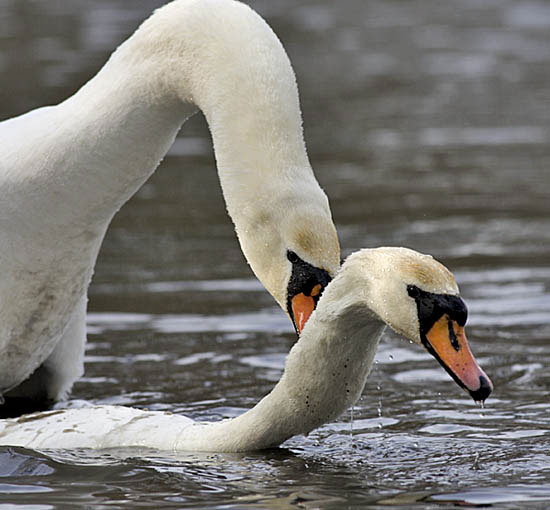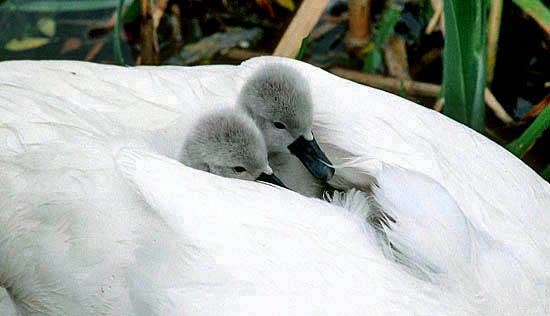Reproduction: Let's Get it On...
Although Mute Swans usually meet their mate around age two, they do not start breeding until age three or four. The reproductive rate of swans is more or less constant. Each pair usually lays one set of eggs each season. The number of eggs produced is typical of the species and is probably governed by inheritance and environmental factors. The Mute Swan has a mean clutch of between five to ten eggs, but the average is around 6.
The male Mute Swan
participates to a large extent in raising the family.
This process usually takes at least six months and
therefore it is important that a
 firm bond
exists between both parents in the family.
To
ensure this, courtship is a slow process.
After this process has occurred, the male gathers nesting
material and builds a shallow mound for the nest.
It is often large – up to six feet in diameter – and made
of reeds and grasses.
The Mute Swan can also
build a semi-floating nest extremely close to water if they
choose to. While the cob is constructing and
guarding the nest, the female feeds enormously.
Green food builds up the reserves needed for egg
production and for the period of incubation when she seldom
leaves the nest.
firm bond
exists between both parents in the family.
To
ensure this, courtship is a slow process.
After this process has occurred, the male gathers nesting
material and builds a shallow mound for the nest.
It is often large – up to six feet in diameter – and made
of reeds and grasses.
The Mute Swan can also
build a semi-floating nest extremely close to water if they
choose to. While the cob is constructing and
guarding the nest, the female feeds enormously.
Green food builds up the reserves needed for egg
production and for the period of incubation when she seldom
leaves the nest.
Swans’ eggs are amongst the largest in the bird world. The Mute Swan’s eggs are almost equally rounded at both ends and aren’t the conventional ‘’egg-shape”. Their eggs are also pale green with a chalky covering.
To ensure that the cygnets
will all hatch out together, incubation usually starts after the
clutch is complete.
For the Mute Swan, it has
been reported that only the female incubates the eggs, although
occasionally the male may sit on the_IMG_5012[1].jpg) nest while she is absent,
guarding them.
The incubation period is said
to last about 36 days. Hatching of the eggs tends to
coincide with the period in which the food supplies and weather
conditions are favorable.
Hatching is
announced by faint clicking’s from the egg and takes
approximately two days. After they have made their way of out of
the egg, they accept the first large moving objects they see as
their parents.
These are typically their
parents but there have been cases where they will readily accept
other swans, birds or even HUMANS as their parents.
nest while she is absent,
guarding them.
The incubation period is said
to last about 36 days. Hatching of the eggs tends to
coincide with the period in which the food supplies and weather
conditions are favorable.
Hatching is
announced by faint clicking’s from the egg and takes
approximately two days. After they have made their way of out of
the egg, they accept the first large moving objects they see as
their parents.
These are typically their
parents but there have been cases where they will readily accept
other swans, birds or even HUMANS as their parents.
 Mute Swans usually carry their
cygnets on their back.
The obvious advantages
to this are that the cygnets can sleep, warm and dry among the
feathers without having
to move ashore.
When they are in this
position, they are also out of reach of most predators.
Both
parents participate, but the female usually does more carrying
than the male.
Mute Swans usually carry their
cygnets on their back.
The obvious advantages
to this are that the cygnets can sleep, warm and dry among the
feathers without having
to move ashore.
When they are in this
position, they are also out of reach of most predators.
Both
parents participate, but the female usually does more carrying
than the male.
Click on the Next button to find out about Mute Swan interactions!